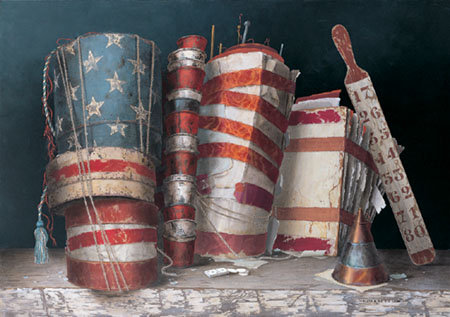Elena and Michel Gran
dal 30/5/2007 al 22/6/2007
Segnalato da
30/5/2007
Elena and Michel Gran
Albemarle Gallery, London
The 2 artists are the most eminent practitioners of trompe l'oeil still life painting at work today, celebrated for their astounding technical skills, and the sleight of hand with which they marshal their deliberately deceptive compositions.

USA: Indipence to Coca-cola
Elena and Michel Gran are the most eminent practitioners of trompe l’oeil still life painting at work today, celebrated for their astounding technical skills, and the sleight of hand with which they marshal their deliberately deceptive compositions. In this sense it seems appropriate that the United States, and in particular, the American flag, should provide the main subject-matter for this new exhibition of their work. After flourishing in Europe during the 17th and 18th centuries, trompe l’oeil took refuge in America in the 19th. The greatest exponents of this branch of painting were at that time American, not European. Pre-eminent among them were William Harnett [1848-1892] and John Frederick Peto [1854-1907].
Various explanations have been offered for the sudden pre-eminence of Americans in this field. The most convincing is that trompe l’oeil was an egalitarian art form, something everyone could enjoy, without needing to refer to any very elaborate cultural background, and that this suited the needs of what was then still a new nation.
To my knowledge, the American flag does not play a role in paintings by the two artists I have just named. It has since, however, become one of the key subjects in American art. In particular, there is the famous series of Flags by Jasper Johns, dating from the mid-1950s, which marked the first stirrings of what was to become Pop Art. The instant celebrity that these paintings by Johns enjoyed in America was due not simply to their originality as art works – in the context provided by an Abstract Impressionist movement whose energy was then just beginning to fail – but also to the way they used an image with fundamental meaning for American society. In the United States the flag – the ‘Star Spangled Banner’ supposedly designed by George Washington himself – is seen as something that embodies the soul of the nation.
The Grans are not American. They are of Russian origin, and they live in Paris not in New York. Why should they choose the American flag as their theme at this particular moment? In some ways the answer is obvious. Their exhibition opens at a moment when American values are increasingly being called into question – most of all by America’s usual collaborators and allies in Western Europe. ‘Homage to Betsy’, which is one of their simplest compositions, seems to be openly critical. The American flag has undergone a number of mutations as the nation has grown. This painting is based on the very first version that, according to unreliable legend, was made in 1776 by Betsy Ross, a professional flag-maker who worked for the Pennsylvania shipyards. It features thirteen stars arranged in a circle. These symbolize the thirteen original states of the American Union. In the Grans’ version, the stripes are faded boards, and the stars have become irregular spatters of white paint, on a blue notice issued by a British 19th century railway company. The fact that the notice deals with lost or mislaid property suggests that America still retains a colonial mentality in its relationship to Britain.
Other paintings that play ingeniously with the idea of the American flag are ‘Americana’, where the image is ingeniously constructed from packaging and stacked paper cups, and ‘Uncle Sam’, in which the personification of America presides over and image constructed from a huge variety of different small objects, among them old labels and old playing cards. Here the effect is nostalgic rather than satirical. Satire returns in ‘Coca Cola’, which plays with a commercial logo that has become as emblematic of the American way of life as the Stars and Stripes. Painted on an old sign board that has lost some of its planks, so that iconic image becomes dislocated, this seems to offer the idea that a once dominant culture is now in decline. Yet it also makes quite a different point – something that contradicts the first and stands in the way of too glib an interpretation. This point is that the logo, dislocated as it is, remains instantly recognizable. We cannot, even if we wish to, get away from the idea of America. The flag images say the same thing.
What these paintings tell us is that trompe l’oeil has now entered a wholly different sphere. It is no longer concerned with a simplistic desire to astonish, or to show off bravura technical skills, in the manner of a gifted violinist throwing off a difficult Paganini Caprice. The Grans use it for its metaphysical dimension. Seemingly precise, the images, on closer examination, are full of ambiguities. They are ambiguous, not about the appearance of things, but about the crisscrossing meanings that can be elicited from certain combinations of objects. In a certain sense, this characteristic strikes me as profoundly Russian, despite the Grans long residence outside that country. The Russian art and literature of the 19th century, one of the most concentrated creative outbursts to have occurred in any country, took place in a context of stringent tsarist censorship, but also of an intense concern for social issues and the whole political situation of that time. Russian painters and writers learned to symbolize rather than say. The Grans are the inheritors of that tradition. The more you look, the more there is to discover.
Edward Lucie-Smith
Opening may 31, 2007
Albemarle Gallery
49 Albemarle Street - London
Free admission



